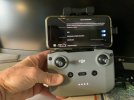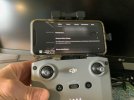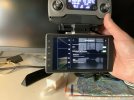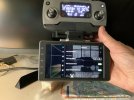You are using an out of date browser. It may not display this or other websites correctly.
You should upgrade or use an alternative browser.
You should upgrade or use an alternative browser.
Can someone please explain Remote ID Rules to me
- Thread starter Dale D
- Start date
... Given the recent opinion of the FAA that anyone who posts a drone video to YouTube falls under part 107, even if the drone is < 255 g., many mini owners will have to comply with the Remote ID edict.
Cite to that opinion, please.
@rxlawdude ...
Yes.., please site the assertion with an FAA document.
I do not believe that posting to YouTube alone can make a video commercial under part 107 rules or any others.
Yes.., please site the assertion with an FAA document.
I do not believe that posting to YouTube alone can make a video commercial under part 107 rules or any others.
Correction .. one FAA staff member expressed that (quite wrong) opinion in a video that has been discussed in this forum recently.Given the recent opinion of the FAA that anyone who posts a drone video to YouTube falls under part 107
But it is not true that the FAA's official opinion is that anyone who posts a drone video to YouTube falls under part 107.
To see the FAA's thoughts on the matter see here:
FAA: Home
Note particularly the sentence after C3 which states:
NOTE: Electronic media posted on a video website does not automatically constitute a commercial operation or commercial purpose, or other non-hobby or non-recreational use.
What id like to know is how Remote ID is to be transmitted. That is after all a generic term that's already included in the Mavics.
WiFi was mentioned, but WiFi how?
Not to mention the channels are already crowded, particularly the 2.4Ghz band, that each of us need to use up another channel?
I did read at least the proposed internet connection requirement was dropped.
WiFi was mentioned, but WiFi how?
Not to mention the channels are already crowded, particularly the 2.4Ghz band, that each of us need to use up another channel?
I did read at least the proposed internet connection requirement was dropped.
cavemanbob
New Member
It does seem that it's easier than one might suppose to run afoul of the FAA regs on hobby/recreational use of the drone. For instance, one need not have any advertising or commercial interest expressed in a particular video a person incorporates drone footage into, but if any other videos on that user's channel, current or future, do have, that seems to be sufficient to violate the regs. If any of your videos on your channel are monetized, that may be sufficient to be deemed a violation. What is/isn't of commercial interest can be subjective at times, and while the FAA does tend to initially take an advisory educational approach to these kinds of violations, there is no mandate that they must take such an approach.
That said, I think it is somewhat heavy-handed to include older drones in new regulation which requires hardware support that isn't available in the older drones, the old drone hardware wears out, crashes out or is just replaced with new hardware which is under continuous refinement with new and better features. How many five year old consumer grade drones are getting any significant air time?
That said, I think it is somewhat heavy-handed to include older drones in new regulation which requires hardware support that isn't available in the older drones, the old drone hardware wears out, crashes out or is just replaced with new hardware which is under continuous refinement with new and better features. How many five year old consumer grade drones are getting any significant air time?
Last edited:
anotherlab
Well-Known Member
No, that was clear in the FAA documentation.Hopefully grandfathered somehow.
Jet skier
Well-Known Member
Did you notice that nothing was even mentioned about flying BVLOS. I thought they were going to allow it for some situationsActually they have... it’s in the full document... 18 months from implementation date for manufacturers and 30 months for operators of currently produced/sold drones
Asan aside... this will impact ALL UAS sold in the U.S.
Cant really be about safety.
If you are doing something dodgy or illegal you generally arent worried about rules anyway, so will likely find a way to disable the broadcast.
Once again it is only the people who already follow the rules who will have to pay to upgrade their equipment.
If you are doing something dodgy or illegal you generally arent worried about rules anyway, so will likely find a way to disable the broadcast.
Once again it is only the people who already follow the rules who will have to pay to upgrade their equipment.
anotherlab
Well-Known Member
See the footnote on page 11 from the Remote ID Final Rule document.Did you notice that nothing was even mentioned about flying BVLOS. I thought they were going to allow it for some situations
This document was mainly about RID.Remote ID Final Rule document said:(2) Part 89 limits unmanned aircraft without remote identification and unmanned aircraft with remote identification broadcast modules to visual line of sight operations. Nothing in part 89 authorizes beyond visual line of sight (BVLOS) operations for any unmanned aircraft; such authority will spring from other FAA regulations.
There is a Remote ID tab on the MA2 (and I expect the MM2) but it currently doesn't do anything. I say that there used to be, I haven't really looked lately after all the app updates. It would probably be a firmware update for those two at least. The other option would be a broadcast module fitted to your older non-compliant drone. What they will look like and all, I have no idea. ANSI will gladly charge you $85 for the specifications though...No drone presently made has the hardware for the proposed (That we know of.... But DJI is sneaky), so no it won't be a firmware for existing drones.
Attachments
Freebird32
Well-Known Member
- Joined
- May 12, 2017
- Messages
- 52
- Reactions
- 27
It is about a power grab by the commercial companies who have their goal set on drone deliveries. Very simple. They needed the airspace that was left as uncontrolled / hobbyist airspace for their drone delivery scheme but couldn't do that without the FAA enforcement and remote ID, just like commercial airlines use to avoid each other in controlled airspace. These big companies have an extremely large and well funded lobbying campaign.Cant really be about safety.
Done under the guise of safety, although not supported by any detailed hazard analysis, they also reacted to the general fear that drones would be involved in accidents with full size aircraft based on the few crazies that have used drones purposely near full sized aircraft. I don't think there are any fatalities recorded due to drones, but that didn't matter.
RandyShmoo
New Member
I had a hard time understanding this as well, as I'm a newbie with all this to begin with. I just got my first drone, a Mavic 2, and then got this and was a bit confused. As far as the Remote ID ruling, I found an easy yet thorough explanation here: What will the FAA's Remote ID Rule mean for you? - DroneDJHi All:
Just received this in my e-mail. Lots of government gobble-di-gook. Can someone out there please translate this into a few cogent sentences for me?
WASHINGTON — The U.S. Department of Transportation’s Federal Aviation Administration (FAA) today announced final rules for Unmanned Aircraft (UA), commonly known as drones. The new rules will require Remote Identification (Remote ID) of drones and allow operators of small drones to fly over people and at night under certain conditions. These rules come at a time when drones represent the fastest-growing segment in the entire transportation sector – with currently over 1.7 million drone registrations and 203,000 FAA-certificated remote pilots.
Remote ID will help mitigate risks associated with expanded drone operations, such as flights over people and at night, and both rules support technological and operational innovation and advancements.
“These final rules carefully address safety, security and privacy concerns while advancing opportunities for innovation and utilization of drone technology,” said U.S. Secretary of Transportation Elaine L. Chao.
Remote ID (PDF) is a major step toward the full integration of drones into the national airspace system. Remote ID provides identification of drones in flight as well as the location of their control stations, providing crucial information to our national security agencies and law enforcement partners, and other officials charged with ensuring public safety. Airspace awareness reduces the risk of drone interference with other aircraft and people and property on the ground.
Equipping drones with Remote ID technology builds on previous steps taken by the FAA and the drone industry to integrate operations safely into the national airspace system. Part 107 of the federal aviation regulations currently prohibits covered drone operations over people and at night unless the operator obtains a waiver from the FAA. The new FAA regulations jointly provide increased flexibility to conduct certain small UAS without obtaining waiver.
“The new rules make way for the further integration of drones into our airspace by addressing safety and security concerns,” said FAA Administrator Steve Dickson. “They get us closer to the day when we will more routinely see drone operations such as the delivery of packages.”
The Remote ID rule (PDF) applies to all operators of drones that require FAA registration. There are three ways to comply with the operational requirements:
1. Operate a standard Remote ID drone that broadcasts identification and location information of the drone and control station;
2. Operate a drone with a Remote ID broadcast module (may be a separate device attached to the drone), which broadcasts identification, location, and take-off information; or
3. Operate a drone without Remote ID but at specific FAA-recognized identification areas.
The Operations Over People and at Night rule (PDF) applies to Part 107 operators. The ability to fly over people and moving vehicles varies depending on the level of risk a small drone operation presents to people on the ground. Operations are permitted based on four categories, which can be found in the executive summary (PDF) accompanying the rule. Additionally, this rule allows for operations at night under certain conditions.
The final rule requires that small drone operators have their remote pilot certificate and identification in their physical possession when operating, ready to present to authorities if needed. This rule also expands the class of authorities who may request these forms from a remote pilot. The final rule replaces the requirement to complete a recurrent test every 24 calendar months with the requirement to complete updated recurrent training that includes operating at night in identified subject areas.
Both rules will become effective 60 days after publication in the Federal Register. The Remote ID rule includes two compliance dates. Drone manufacturers will have 18 months to begin producing drones with Remote ID, with operators having an additional year to start using drones with Remote ID.Hi all"
Hope that helps.
Jeff A
Well Worn Member
Russ at the 51 Drones YouTube Channel does a good job of explaining the details of Remote ID. Click here to read his work.
Um, they aren't remotely operated.What type of system do para-gliders, balloonists, hang gliders, etc, use?
Similar threads
- Replies
- 0
- Views
- 600
- Replies
- 5
- Views
- 5K
- Replies
- 19
- Views
- 2K
DJI Drone Deals
New Threads
-
-
-
-
-
Mini 4 Pro Istanbul where the East meets West - Karaköy
- Started by MPone
- Replies: 0
Members online
Total: 1,591 (members: 8, guests: 1,583)














